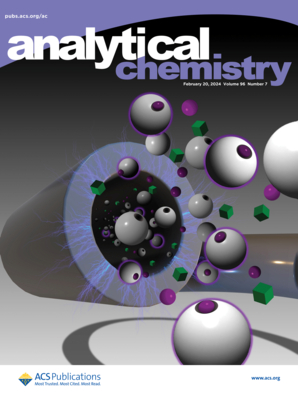利用钯位的拓扑和化学紊乱实现破纪录的甲酸电催化氧化
IF 6.7
1区 化学
Q1 CHEMISTRY, ANALYTICAL
引用次数: 0
摘要
设计钯基甲酸氧化反应(FAOR)催化剂,以便在催化活性、途径选择性和抗毒性方面实现重大突破,既紧迫又具有挑战性。本文通过开创性地结合拓扑和化学无序性的新型催化剂设计,开发出一类具有多孔网络的新型 PdCuLaYMnW 高熵无定形合金(Net-Pd-HEAA),作为一种高活性、高选择性和高稳定性的甲酸氧化反应电催化剂,来应对这些挑战。这种新型 Net-Pd-HEAA 具有破纪录的 FAOR 性能,其质量活性和比活性分别达到了 5.94 A mgPd-1 和 8.94 mA cm-2,超过了之前报道的所有钯基催化剂,与先进的铂基催化剂相比具有很强的竞争力。同时,Net-Pd-HEAA 在加速耐久性试验(ADT)和计时器测定法(CA)试验中表现出非凡的稳定性。先进的表征和原位光谱分析显示,极度无序的原子结构有效地调节了钯位点的几何和电子结构,提高了活性中间体的覆盖率,促进了脱氢途径,并抑制了 CO 的产生/吸附。此外,在质子交换膜电解水(PEMWE)中用作阳极催化剂时,Net-Pd-HEAA 只需要 1.28 V 的电位就能获得 1 A cm-2 的电流密度,并能在高腐蚀性电解质中稳定运行 100 小时以上。本文章由计算机程序翻译,如有差异,请以英文原文为准。

Engineering Topological and Chemical Disorder in Pd Sites for Record-Breaking Formic Acid Electrocatalytic Oxidation
Designing palladium-based formic acid oxidation reaction (FAOR) catalysts to achieve significant breakthroughs in catalytic activity, pathway selectivity, and toxicity resistance is both urgent and challenging. Here, these challenges are addressed by pioneering a novel catalyst design that incorporates both topological and chemical disorder, developing a new class of PdCuLaYMnW high-entropy amorphous alloys with a porous network (Net-Pd-HEAA) as a highly active, selective, and stable FAOR electrocatalyst. This novel Net-Pd-HEAA demonstrates record-breaking FAOR performance, achieving the mass and specific activities of 5.94 A mgPd−1 and 8.94 mA cm−2, respectively, surpassing all previously reported Pd-based catalysts and showing strong competitiveness against advanced Pt-based catalysts. Simulataneously, Net-Pd-HEAA exhibits extraordinary stability in accelerated durability tests (ADT) and chronoamperometry (CA) tests. Advanced characterization and in situ, spectral analysis reveal that the extremely disordered atomic structure effectively regulates the geometric and electronic structure of the Pd sites, enhancing active intermediate coverage, facilitating dehydrogenation pathway, and inhibiting the production/adsorption of CO. Furthermore, when employed as the anode catalyst in proton exchange membrane water electrolysis (PEMWE), Net-Pd-HEAA only requires a potential of 1.28 V to obtain a current density of 1 A cm−2, and operates stably in a highly corrosive electrolyte for over 100 h.
求助全文
通过发布文献求助,成功后即可免费获取论文全文。
去求助
来源期刊

Analytical Chemistry
化学-分析化学
CiteScore
12.10
自引率
12.20%
发文量
1949
审稿时长
1.4 months
期刊介绍:
Analytical Chemistry, a peer-reviewed research journal, focuses on disseminating new and original knowledge across all branches of analytical chemistry. Fundamental articles may explore general principles of chemical measurement science and need not directly address existing or potential analytical methodology. They can be entirely theoretical or report experimental results. Contributions may cover various phases of analytical operations, including sampling, bioanalysis, electrochemistry, mass spectrometry, microscale and nanoscale systems, environmental analysis, separations, spectroscopy, chemical reactions and selectivity, instrumentation, imaging, surface analysis, and data processing. Papers discussing known analytical methods should present a significant, original application of the method, a notable improvement, or results on an important analyte.
 求助内容:
求助内容: 应助结果提醒方式:
应助结果提醒方式:


